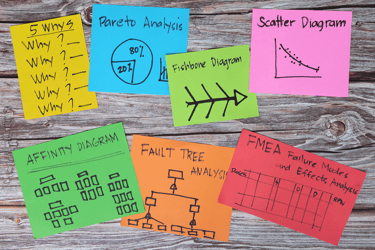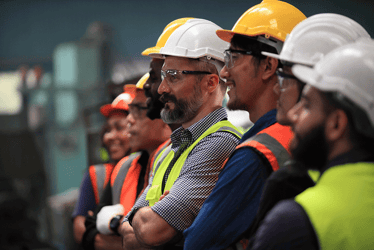The Packaging Industry's Sustainability Challenge: Why ERP Systems Are Essential for Success A straightforward guide to navigating sustainability regulations across folding carton, flexible...
Exploring AI technologies for manufacturing: A primer for converters
Artificial Intelligence (AI) is a term that's frequently heard in today’s industrial world, often in the context of Generative AI.
However, AI encompasses much more and has been around for several decades.
For packaging converters—companies transforming raw materials into finished packaging products—understanding these AI technologies is essential in identifying what you should prioritize and adopt. This prioritization is largely based on the most pressing goals of your company. As you will see, different technologies can improve different areas of the company from the front office to manufacturing.
This article, the first in a three-part series, aims to clarify the different types of AI technologies available and their potential applications.
Contents
- The scope of artificial intelligence in manufacturing
- The rise of generative AI
- Key differences between generative and non-generative AI
- Making the right choice
- Call to action and next steps
The scope of artificial intelligence in manufacturing
While the buzz today often centers around Generative AI, it's important to recognize the broader spectrum of AI technologies, particularly non-generative AI, which has been instrumental in various industrial applications. Here are some key non-generative AI techniques:
-
Optimization: This type of AI focuses on finding the best solutions from a set of possible options. For example, optimization algorithms can enhance production schedules by grouping colors, like materials or tooling requirements to sequence orders more efficiently.
-
Rules/Heuristics: These are predefined rules or heuristics used to make decisions or solve problems. In manufacturing, rule-based systems can streamline quality control processes by automatically rejecting products that don’t meet specified criteria, thus ensuring consistency and reducing the need for manual inspection.
-
Simulation: Simulation involves modeling and simulating real-world processes to predict outcomes. By simulating different schedule options, converters can test different scenarios and process changes in a virtual environment, identifying potential bottlenecks and optimizing workflows without disrupting actual operations.
-
Graphs: Graph-based AI can be used in customer service and sales context to analyze order history. For instance, a sales representative can use graph algorithms to predict future purchases by examining the relationships and patterns in past orders. This helps in tailoring sales efforts and stocking the right products to meet customer demands.
The rise of generative AI
Generative AI, a more recent development, is a subset of AI focused on generating new data that is like existing. This also includes using natural language to “prompt” the system for information in a very intuitive way. Although it is powerful and offers creative solutions, its primary distinction from non-generative AI lies in its ability to produce new content or utilize natural language. Great examples are readily available platforms such as ChatGPT or CoPilot.
Key differences between generative and non-generative AI
Understanding the distinctions between generative and non-generative AI is crucial for converters considering AI integration into their business processes:
-
Non-Generative AI (more common, been around longer): Focused on analyzing, predicting, and optimizing existing data, non-generative AI does not create new content. Instead, it enhances efficiency and decision-making processes by leveraging historical data. Examples include optimizing production schedules, predictive maintenance, and supply chain management. These usually are custom projects involving specially designed software packages (like our own Printflow, converting scheduling application). While it can involve more planning and implementation, generally results are predictable and impactful.
-
Generative AI: This technology produces new content and can offer more intuitive natural-language interactions. It requires large datasets to train models effectively. The advantage is that the interactions are more “human-like” user friendly with multiple prompts available to get the information/results needed. The easiest way to apply this technology to your business is through publicly available commercial offerings such as CoPilot. CoPilot is very simple to implement through a Microsoft add-on subscription and can bring a plethora of benefits to your teams such as generating content, data analysis, etc.
-
Combined: NonGen and GenAI can be combined with integrations (APIs) to provide very powerful results. One great example is to leverage the powerful language models of ChatGPI to allow your employees (or even customers) utilize natural language prompts, to query your internal production and estimating data. They can simply ask “Which of the 16 oz frozen pouch line products had the lowest margins” and bingo, they would get a dashboard showing all the incidence. A follow-up question could ask about the customer or similar products with better margins, for example. It’s like a conversation!
Making the right choice
For decision-makers in the packaging converting industry who want to leverage this powerful new tool, the key is to define and prioritize key business concerns. Then, use appropriate AI technology for the specific needs. It’s like using the right tool in the shed to fix something at home. Non-generative AI provides robust solutions for optimizing current processes, while generative AI opens new avenues for gaining strategic insights and improving decision-making.
Call to action and next steps
Ready to explore how AI can transform your manufacturing processes? Here are some recommended steps to get started:
-
Start Small: Equip your team to work with AI technologies. Investing in on-line training on CoPilot or ChatGPT will help your staff start to understand AI tools effectively.
-
Assess Your Needs: Identify the specific areas in your manufacturing process that could benefit from AI technologies. This could be optimizing production schedules, improving quality control, or enhancing supply chain logistics.
-
Pilot Projects: Start with small pilot projects to test the effectiveness of different AI (Non-GenAI and GenAI) solutions. This allows you to gather data and assess the impact before scaling up.
-
Consult Experts: For larger projects in manufacturing, that require tailored approaches, reach out to companies and specialists that have AI experience in manufacturing. They can help you understand the best technologies for your needs and guide you through the integration process.
By embracing the right AI tools, converters can stay ahead in an increasingly competitive market and contribute to a more sustainable future.
To discover practical, easy-to-implement ways that converting companies can leverage GenAI, with real-world use cases that deliver immediate value, read part 2 in this series of blogs: Practical Ways Converting Companies Can Leverage Generative AI.



